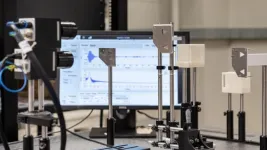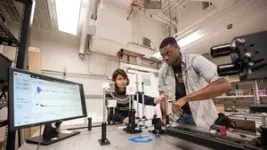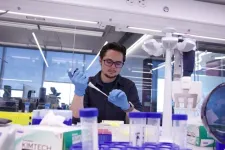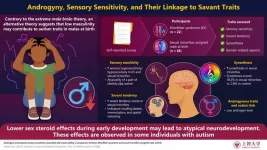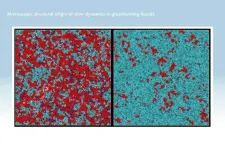(Press-News.org) Researchers have found a low-power, inexpensive way for large numbers of devices, such as machines in factories and equipment in labs, to share information by efficiently using signals at untapped high frequencies.
The technology could immediately enable low-cost, efficient real-time monitoring in industrial settings, such as tracking the condition of manufacturing robots or detecting gas leaks in refineries, by eliminating the need for power-hungry signal transmitters. The researchers said that with some engineering improvements, the technology could be used for large-scale applications like smart cities and agriculture.
The technology is an advanced version of a device that transmits data in a wireless system, commonly known as a tag. The new tag can support data transmission for a large network of devices using a technique called backscattering. This is where a central reader sends a signal to a sensor tag to gather information, and the tag reflects this ambient signal directly back to the reader. Backscattering is already used in simple systems like smart payment and building entry cards, but until now has only been possible at low frequencies.
The low frequency limit poses a problem when many devices try to communicate at the same time because when more signals are introduced, they are more likely to run into one another and get jumbled up. Conventional backscatter designs also have slow communication speeds, as lower frequency signals have limitations on how much information can travel back and forth at once.
The new tag, developed by researchers at Princeton, Rice University and Brown University, is the first of its kind that can use backscattering in the sub-terahertz range, a high-frequency portion of the radio spectrum. This range can support high-speed data transmission across broad bandwidths. The development means it could be possible to power signal transmission for dense networks of devices using passive tags, saving significant power and infrastructure compared to conventional wireless systems.
“I believe this technology will find applications in many interesting settings,” said Yasaman Ghasempour, assistant professor of electrical and computer engineering at Princeton and the study’s principal investigator. “Despite the conventional wisdom, this paper shows that it is possible to have low-power, scalable communication in the sub-terahertz range.”
The paper was published Oct. 9 in Nature Communications.
Using backscattering at higher frequencies is challenging because the signals are more susceptible to fading as they propagate and must be very precise to travel long distances. “The reader has to form a narrow pencil-shaped beam to shine into the tag’s precise location, and the low-power tag should do the same without consuming any power. That’s the real challenge,” Ghasempour said.
Traditional backscatter tags reflect signals back to their source using simple antennas that typically broadcast the energy in all directions, causing only a portion of the energy to reach back to the reader. While some advanced tags can adjust the direction of their signal, their ability to do so is limited, and they’re restricted to a narrow range of frequencies. Ghasempour said that achieving sub-terahertz backscattering required the team to rethink the entire architecture of the tag. “It wouldn’t work to use the same old hardware design and scale it up,” she said.
To address these limitations, the researchers came up with an entirely new antenna structure. The new antennas allow the direction of the signal to change automatically in response to changes in frequency. By doing this, the tag can steer the signal to enable longer range communication and avoid interference from other signals. In other words, the interference footprint of each tag is limited in spatial and spectral domains.
Ghasempour said she hopes that others will read this paper and find engineering improvements for advanced applications. By implementing a way to amplify signals in the system at low costs, for example, the technology could power sensor networks across cities to monitor air quality or traffic flow.
The tags could be placed on traffic signs to be detected by self-driving cars, as they can use radio waves to convey messages like “stop” or “yield” even when visibility is blocked by fog or snow. In agriculture, the technology could help create expansive networks of soil sensors across fields or forests, providing real-time data on moisture levels or temperature.
Ghasempour said that developing low-power data modulators in these kinds of systems is an active area of research, and that this innovation is a step toward decreasing cost and power consumption for the entire wireless system.
The paper “A frequency-agile retrodirective tag for large-scale sub-terahertz data backscattering” was published Oct. 9 in Nature Communications. Besides Ghasempour, authors include Atsutse Kludze, Junichiro Kono and Daniel M. Mittleman. Support for this research was provided in part by the National Science Foundation and the U.S. Air Force Office of Scientific Research.
END
Low-cost system will improve communications among industrial machines
An advanced signal transmission tag saves power for wireless systems by efficiently reflecting signals at high frequencies using no battery power, eliminating the need for power-hungry signal transmitters
2025-01-08
ELSE PRESS RELEASES FROM THIS DATE:
Elderberry juice shows benefits for weight management, metabolic health
2025-01-08
SPOKANE, Wash.—Elderberry juice may be a potent tool for weight management and enhancing metabolic health, according to a recent Washington State University-led study.
A clinical trial published in the journal Nutrients found that drinking 12 ounces of elderberry juice daily for a week causes positive changes in the gut microbiome and improves glucose tolerance and fat oxidation.
Elderberry, a small dark purple berry found on elder trees native to Europe, is commonly used as a medicinal plant and supplement to promote immune function. Its other potential health benefits are poorly understood, however.
“Elderberry ...
A new era in genetic engineering
2025-01-08
Influential inventions often combine existing tools in new ways. The iPhone, for instance, amalgamated the telephone, web browser and camera, among many other devices.
The same is now possible in gene editing. Rather than employ separate tools for editing genes and regulating their expression, these distinct goals can now be combined into a single tool that can simultaneously and independently address different genetic diseases in the same cell.
Merging Gene Editing and Regulation
In a new paper in Nature ...
Study identifies coastal black pine trees resistant to tsunamis and strong winds
2025-01-08
Researchers in Japan have found that the taller the Japanese black pine trees (Pinus thunbergii) along the coast, the deeper their roots go into the ground. Trees with deeper roots are more resistant to damage from tsunamis and strong winds. Their findings suggest that the resilience of coastal P. thunbergii trees may be improved by inducing deep root growth, specifically in short trees. The study was published in the Journal of Forest Research.
Many P. thunbergii trees have been planted in coastal forests in Japan because they are salt-tolerant and can grow in sandy soils lacking nutrients. P. thunbergii ...
From gender dysphoria to special skills: decoding the link
2025-01-08
Why have males been overrepresented among geniuses in STEM fields so far? A popular biological psychological explanation is the Extreme Male Brain Theory (EMB), which suggests that an overdose of prenatal androgen (male hormone) leads to the hyper-masculine brain type, characterized by a strong geek tendency and insensitivity to others' feelings. This theory explains the etiology of autism spectrum disorder (ASD) and inevitably connects prenatal androgen action with talents in specific fields.
However, the current research shows evidence that the opposite story might be true: reduced androgen exposure in ...
Study advances possible blood test for early-stage Alzheimer’s disease
2025-01-08
Declining blood levels of two molecules that occur naturally in the body track closely with worsening Alzheimer’s disease, particularly in women. Levels were found to drop gradually, from women with no signs of memory, disorientation, and slowed thinking to those with early signs of mild cognitive impairment. Decreases were more prominent in women with moderate or severe stages of the disease. Declines in men were evident in only one molecule, revealing a disease-specific difference between the sexes.
Six million Americans, most over the age of 65 and predominantly women, are currently ...
New international research collaboration to develop and test an improved dietary supplement for pregnant women
2025-01-08
New international research collaboration to develop and test an improved dietary supplement for pregnant women
Poor nutrition during pregnancy can have serious consequences for both maternal and child health. A new research collaboration – ‘Mother’s Micronutrient Supplement for Pregnancy and Lactation’ (MoMS) – between researchers in Kenya, Norway and Denmark aims to develop and test a new, improved dietary supplement to reduce incidences of low birth weight, improve maternal and child health, and enhance growth and cognitive development in children. MoMS ...
Presenting a path forward for future genetically-modified pig heart transplants: lessons learned from second patient
2025-01-08
Continuing significant advancements in the field of xenotransplantation, surgeon-scientists from the University of Maryland School of Medicine provided an extensive analysis on the second patient in the world to receive a genetically-modified pig organ. Lawrence Faucette, 58, received a pig heart at the University of Maryland Medical Center in 2023 to treat his end-stage heart failure. He lived for 40 days before choosing to forgo additional treatment after the transplant began to fail due to rejection.
The report documenting insights ...
When the past meets the future: Innovative drone mapping unlocks secrets of Bronze Age ‘mega fortress’ in the Caucasus
2025-01-08
A Cranfield University, UK, academic has used drone mapping to investigate a 3000-year-old ‘mega fortress’ in the Caucasus mountains. Dr Nathaniel Erb-Satullo, Senior Lecturer in Architectural Science at Cranfield Forensic Institute, has been researching the site since 2018 with Dimitri Jachvliani, his co-director from the Georgian National Museum, revealing details that re-shape our understanding of the site and contribute to a global reassessment of ancient settlement growth and urbanism.
Fortress settlements in the South Caucasus appeared between 1500-500 BCE, and represent an ...
AI could improve the success of IVF treatment
2025-01-08
During IVF treatment, doctors use ultrasound scans to monitor the size of follicles - small sacs in the ovaries containing eggs - to decide when to give a hormone injection known as the ‘trigger’ to prepare the eggs for collection and ensure that they are ready to be fertilised with sperm to create embryos. The timing of the trigger is a key decision, as it works less effectively if the follicles are too small or too large at the time of administration. After the eggs are collected and fertilised by sperm, an embryo is then selected and implanted into the womb to hopefully lead to pregnancy.
Researchers used ‘Explainable ...
Moving in sync, slowly, in glassy liquids
2025-01-08
Tokyo, Japan – Glass might seem to be an ordinary material we encounter every day, but the physics at play inside are actually quite complex and still not completely understood by scientists. Some panes of glass, such as the stained-glass windows in many Medieval buildings, have remained rigid for centuries, as their constituent molecules are perpetually frozen in a state of disorder. Similarly, supercooled liquids are not quite solid, in the sense that their fundamental particles do not stick to a lattice ...
LAST 30 PRESS RELEASES:
Researchers identify gene that calms the mind and improves attention in mice
Artificial metabolism turns waste CO2 into useful chemicals
Ancient sea anemone sheds light on animal cell type evolution
Begging gene leads to drone food
How climate policies that incentivize and penalize can drive the clean energy transition
Can community awareness campaigns in low-resource areas improve early diagnosis of colorectal cancer?
Stardust study resets how life’s atoms spread through space
Practical education: Clinical scenario-based program development
The impact of family dynamics on eating behaviour – how going home for Christmas can change how you eat
Tracing the quick synthesis of an industrially important catalyst
New software sheds light on cancer’s hidden genetic networks
UT Health San Antonio awarded $3 million in CPRIT grants to bolster cancer research and prevention efforts in South Texas
Third symposium spotlights global challenge of new contaminants in China’s fight against pollution
From straw to soil harmony: International team reveals how biochar supercharges carbon-smart farming
Myeloma: How AI is redrawing the map of cancer care
Manhattan E. Charurat, Ph.D., MHS invested as the Homer and Martha Gudelsky Distinguished Professor in Medicine at the University of Maryland School of Medicine
Insilico Medicine’s Pharma.AI Q4 Winter Launch Recap: Revolutionizing drug discovery with cutting-edge AI innovations, accelerating the path to pharmaceutical superintelligence
Nanoplastics have diet-dependent impacts on digestive system health
Brain neuron death occurs throughout life and increases with age, a natural human protein drug may halt neuron death in Alzheimer’s disease
SPIE and CLP announce the recipients of the 2025 Advanced Photonics Young Innovator Award
Lessons from the Caldor Fire’s Christmas Valley ‘Miracle’
Ant societies rose by trading individual protection for collective power
Research reveals how ancient viral DNA shapes early embryonic development
A molecular gatekeeper that controls protein synthesis
New ‘cloaking device’ concept to shield sensitive tech from magnetic fields
Researchers show impact of mountain building and climate change on alpine biodiversity
Study models the transition from Neanderthals to modern humans in Europe
University of Phoenix College of Doctoral Studies releases white paper on AI-driven skilling to reduce burnout and restore worker autonomy
AIs fail at the game of visual “telephone”
The levers for a sustainable food system
[Press-News.org] Low-cost system will improve communications among industrial machinesAn advanced signal transmission tag saves power for wireless systems by efficiently reflecting signals at high frequencies using no battery power, eliminating the need for power-hungry signal transmitters
